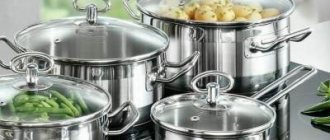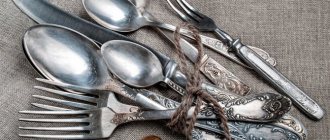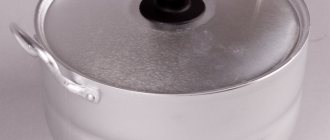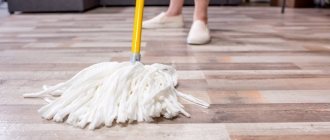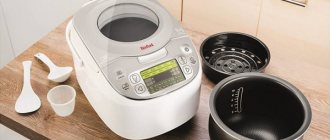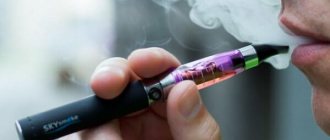/Accessories and decor/Cookware and cutlery/
Untidy spoons and forks can ruin the impression of even the most beautiful dinner. In fact, stainless steel cutlery is the most practical, because it does not rust (very rarely), and blackens and oxidizes much less than cupronickel or silver. But still, over time, they fade, and a black, greasy, tea-colored or limescale coating may appear on them.
- Dirt especially accumulates around raised points, in carvings, recesses of patterns and inscriptions. Cleaning areas with decor is the most difficult and regular washing, as a rule, does not solve the problem.
- It often happens that the main difficulty is cleaning teaspoons (due to deposits from coffee and tea) or the space between the tines of forks.
To clean stainless steel spoons and forks at home, you can buy special products or use what you have in your kitchen cabinet and medicine cabinet.
Single Component Options
Every housewife wants to know how to remove plaque from spoons and forks. A great way is to wipe the items with a cloth soaked in 9% vinegar. There is no need to dilute the liquid. After the procedure, the devices are rinsed well and dried. Vinegar easily removes grease and limescale.
Drinks that contain citric acid cope with various types of contaminants with a bang. Coca-Cola products are perfect for experimentation.
The option, of course, is not the most budget-friendly, but if there is water left without gases, it is not necessary to pour it out. You can clean her inventory. In this case, it is better to use a colorless liquid.
When choosing between Sprite and cola, preference is given to the first drink.
- Oil will help to cope with persistent greasy deposits. Apply a small amount to soft material and rub on forks and spoons. Then, after a few minutes, we begin to wash the dishes as usual. Experienced housewives, please note that olive oil has a greater effect than sunflower oil.
- Potatoes also have properties that are useful for peeling. Starch removes unpleasant plaque and restores shine to objects. It is enough to rub the cutlery with vegetable halves. Thinner potato slices are used between the teeth.
- To combat dirt, toothpaste, powder, citric acid, onion juice, lemon juice, and coffee residues are also used. When choosing a product, the material of the cutlery and the nature of the contamination are taken into account.
Potatoes and its decoction
There are several ways to clean stainless steel with potatoes - using a fresh root vegetable or its decoction:
- In the first case, it is necessary to cut the tuber into two parts and rub the darkened area with the secreted juice. This method is bad only because it requires patience on your part - you need to process each item separately.
- The second option involves boiling spoons in the broth left after cooking potatoes, which allows you to peel items in batches. The effect is achieved similar to that when using fresh vegetables, because the liquid is sufficiently saturated with starch.
Multi-component products
A very effective method is to use a soda solution in boiling water.
So, how to clean spoons and forks by boiling:
- Fill a medium-sized saucepan with water.
- Add two tablespoons of regular soda and table salt to the water.
- You need to stir and heat the mixture.
- We put the instruments there.
- Bring to a boil and cook for about half an hour.
- We drain the hot water. Rinse the cooled utensils under water and wipe with a dry towel.
The method works great, allowing you to defeat even severe pollution, which is why it is very popular. However, there are other options:
- A mixture of baking soda and liquid soap. A mixture of these ingredients removes old stains well and eliminates stickiness. The resulting paste is applied to the stained areas with an unnecessary toothbrush or the back of a sponge.
- Alcohol solution (alcohol plus water in a ratio of 1 to 9). It can restore stainless steel appliances to their former shine and chic.
- A thick paste of baking soda and water.
- Boiling with soda and citric acid (an alternative to boiling with soda and salt)
- Mustard and soda (1 tablespoon per liter of water). Be sure to remember to stir well. The devices are immersed in liquid for 30-40 minutes.
- Using foil. Place a piece of material, glossy side up, on the bottom of a metal dish. There we pour the prepared solution with soda and salt. For 1 liter of water, a tablespoon. Place the devices inside and boil them for 15-20 minutes. Wash and dry.
Mixtures take longer to prepare than single-component products, but the result is worth it. Moreover, all the ingredients are available in every household.
Dentifrice
Not everyone has powder for maintaining oral hygiene, but it can be purchased for a fairly low price in the store or replaced with regular paste.
- It is recommended to first soak the devices in hot water for 30 minutes. To enhance the effect, add a couple of tablespoons of baking soda to the liquid.
- Then clean the stains with a sponge and apply the paste. If using powder, it must be diluted to an identical state.
- Finally, to give the utensils a noticeable shine, wipe dry with a soft cloth.
Professional household chemicals
There are a huge number of different cleaning products sold in stores. The most famous is whiteness. If we clean forks and spoons with white, we follow safety precautions.
Don't forget to wear gloves and try to breathe less fumes.
The composition of bleach, like most household chemicals, includes chlorine, which not only cleans, but also has an antimicrobial effect. The product copes well with stains, however, for some time the cutlery acquires a specific smell.
When purchasing cleaning products, general recommendations are:
- We read on the label what kind of cookware it is intended for.
- We select mixtures without particles that can damage the surfaces of products. Gels and sprays are ideal.
- We buy proven brands with positive reviews (for example, Sanitol, GIF, Topper, etc.)
- In practice, we use it according to the instructions.
- Carefully rinse off any remaining product.
Ammonia + chalk
It is not recommended to replace the bulk component, since it is in crushed form that it has “gentle” abrasive particles that will not harm the surface.
- In a mortar, crush the chalk as finely as possible.
- Transfer to a container unsuitable for food purposes and gradually introduce ammonia. As a result, you should end up with a fairly liquid pulp, somewhat reminiscent of full-fat kefir.
- Remove stains with the resulting mixture. Rinse.
Dishwasher
You can also wash cutlery mechanically by placing it in the dishwasher. It is important to do it correctly in order to get the desired result.
- First remove heavy dirt with a sponge or cloth.
- Place the devices in the machine tray, so that the items do not lie on top of each other.
- Turn on the dishwasher by adding detergent and selecting the desired operating mode. In most cases, the normal mode is able to clean forks and spoons, but if the equipment has dried dirt and greasy stains, it is better to use a more intensive program.
- Drying appliances. Some machines have this mode, but it is better to wipe the devices with your hands using a towel. This makes the forks and spoons look better.
If the dishwasher does not do a good job of cleaning the appliances, the reason may lie in the equipment being clogged, the wrong choice of detergent, or other malfunctions.
Vegetable oil
No matter how paradoxical it may sound, refined oil removes stains of a similar origin quite well. With it you can get rid of fat and dark spots, as well as add shine.
When oils come into contact, a “liquefaction” effect occurs. Just apply a couple of drops to the device and rub vigorously. It is recommended to remove residues with regular dish soap.
Care Tips
Compliance with a number of recommendations will increase the service life of cutlery.
- Do not let dirt dry, wash dishes immediately
- If the stain has dried, pre-soak the forks and spoons.
- The choice of cleaning method for items depends on the raw materials they are made from.
- For example, we clean stainless forks and spoons with a paste of soda or salt, but we clean gold-plated objects with wine vinegar or egg white.
- We do not use cleaning agents or brushes that may leave scratches.
- Always wipe cutlery dry after washing.
- Store in a special place where moisture will not enter.
So, the most common methods for cleaning forks and spoons so they shine at home are described above.
You just have to choose the method you like best. Giving cutlery a new life is not difficult, and with proper care, it can also be done quickly.
Vinegar
To clean devices, it is recommended to use a 9% product. A piece of cotton cloth is moistened with it and the spoons are wiped.
In this case, there is no need to spare the vinegar - it should cover the stains on the stainless steel completely. The product is left in this state for at least a quarter of an hour, after which it is wiped dry.
Tip: if you need to clean more than one device, then simply fill the set with vinegar for the same period of time.
Photo instructions for cleaning spoons and forks
What do you need to know before cleaning your silver?
What is the alloy of your silverware?
What cleans one silver well will leave stains on another. This especially applies to home remedies (soda, salt, citric acid, etc.). The reaction of silver to a cleaning agent depends on the amount of impurities in the composition. So in sample 925 there are about 7-8% impurities, and in sample 800 there are about 10-12%. Therefore, check what the alloy consists of or test the product on a small piece of silver.
Silver service on a festive dinner table
How and with what to polish silver utensils
Silver is a soft metal and scratches easily. Therefore, do not polish it with paper towels, napkins, toilet paper or other rough materials. It is better to use soft flannel material for these purposes.
As for polishing, do it in long, back and forth strokes. Polishing in small circles, on the contrary, is a bad idea. This way there is more chance of scratching the devices.
An example of polishing silver utensils with soft materials
What to do after cleaning and polishing silverware
Clean your silver a week or at least three days before using it. The fact is that only a few days after cleaning does a protective layer form on the surface of the silver, preventing it from changing color. If you do not follow this rule, the silver will quickly darken and cleaning will go down the drain.
Silverware in a case
Why Abrasives Are Not Always Good for Cleaning Silverware
Tooth powder, soda, etc., which are so often used to clean silver, are abrasive substances. If you rub silver with them intensively or do not maintain the proportion, the dishes can be ruined. Therefore, remember, it is better to leave one small speck than to completely ruin the device.
Dark silverware
How to clean plaque from forks
Tap water contains many aggressive components - salts and minerals, which leave an unsightly coating on cutlery. You can get rid of such plaque on your forks using raw potatoes.
You must first grate the potatoes on a baby grater, and then use the hard side of the sponge to wipe the gruel on each utensil separately. All that remains is to rinse the forks and wipe dry.
You can get rid of old fat deposits with the help of dried coffee grounds. You just need to dip a kitchen sponge in the grounds, and then wipe each fork very thoroughly.
How to clean forks between the tines
One proven method will help here. It is necessary to dissolve a little bleaching washing powder in a small amount of hot water. Then you need to immerse the forks in the solution.
After 20-30 minutes, you need to pierce a metal dish scraper with each fork several times - this will clean the teeth of the utensils until they shine. All plaque will remain inside the scraper. This method is very simple and economical.
Do not rush to buy new cutlery if they have become old or have lost their shine. It’s worth trying to use one of the suggested methods to clean even very old or very dirty forks until they shine.
Ammonia
Ammonia diluted with water in a ratio of 1:9 can restore lost shine. To do this, items must be rubbed with this solution. It is better to wash them before use.
This product can also be used to clean silver forks or spoons. To do this, ammonia is combined with water in a ratio of 1:10. Soak forks and spoons in the resulting liquid and rinse after 2 hours.






